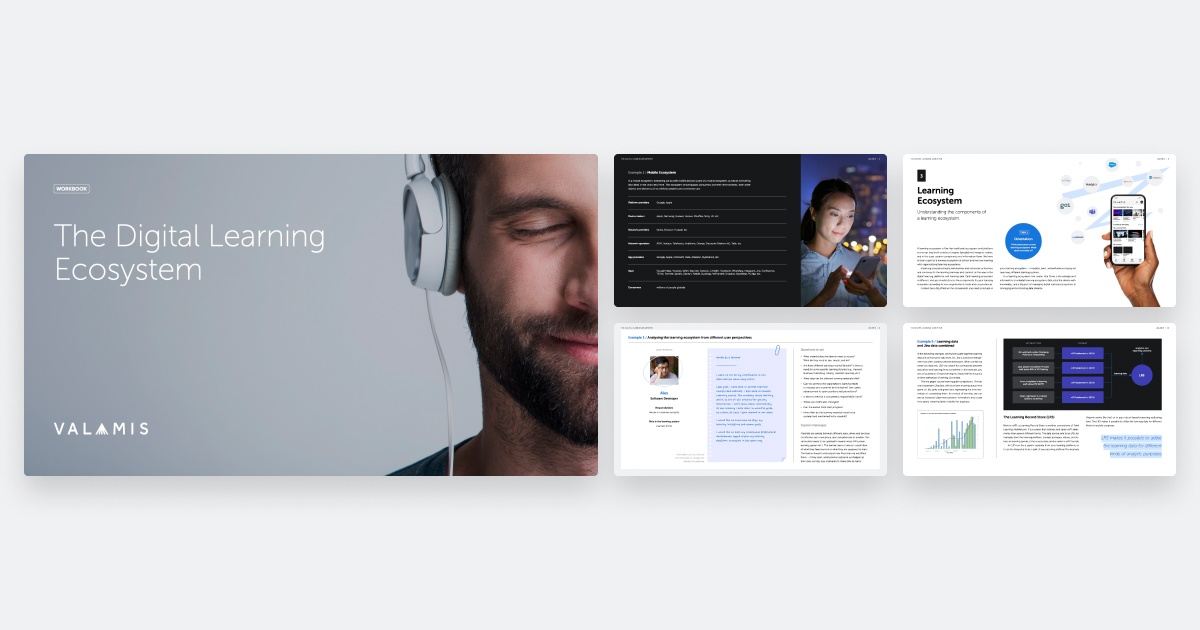Learning Ecosystem
Learn what a learning ecosystem is, why you need it, and how to build it in 5 steps. Discover the new learning technology model.

How employees acquire knowledge and develop new skills is the result of many factors. Organizations can establish training programs and make information available to employees, but the learning experience and overall success of Learning and Development (L&D) efforts come down to the learning ecosystem as a whole.
In this article, we will discuss:
- What is a learning ecosystem?
- Learning ecosystem vs. learning culture
- Key components of your learning ecosystem
- Why you need a learning ecosystem
- How to build a corporate learning ecosystem
What is a learning ecosystem?
In the context of L&D at a business, this can include the people, content, technology, data, tools, culture, strategy, governance, and any other factor that affects how an employee acquires new knowledge.
However, a learning ecosystem does not only look at these components in isolation. Instead, it takes a holistic view to understand the interactions between each of them and how they combine to produce the final learning experience.
The phrase “ecosystem” is borrowed from biology, referring to the web of interconnected relationships between different living organisms and their physical environment. This idea translates to L&D, with learning ecosystems reflecting the complex relationships between employees and the multitude of factors that affect what, how, and when they learn.
Similar to a biological ecosystem, learning ecosystems can be healthy, self-sustaining, or under threat. Organizations can assist their learning ecosystem by developing and nurturing practices that help it thrive.
When successful, the interactions between a learning ecosystem’s components enhance one another to become more than the sum of their parts. In these situations, not only is each element within the wider system a net positive, but they also combine in a way that compounds the benefit each can offer.
While L&D efforts often focus on formal, structured learning, effective ecosystems positively impact all learning, even informal. For example, content and strategy directly affect formal employee training programs. But the people and culture of an organization support how people learn in less formal settings such as on-the-job training and self-study.
Learning ecosystems are a broad idea, and their application goes beyond business. Examples can include social media platforms such as LinkedIn. People log in to LinkedIn every day and learn from its ecosystem of users and the content they post.
However, in this piece, we will focus on learning ecosystems that form in workplace environments. Just like workplace cultures, every organization has a learning ecosystem. You can either be proactive and try to develop one that aligns with your company’s goals or sit back and see what naturally forms.
The digital learning ecosystem workbook
You’ll get a list of useful questions and tasks to help you know your learning space better and ways to improve it.
DOWNLOAD WORKBOOKLearning ecosystem vs learning culture
While closely related, a learning ecosystem differs from a learning culture.
A learning culture includes the measures put in place by an organization to prioritize employee education and development (values, practices, processes, etc.). Developing a healthy learning culture helps to improve the impact of corporate training programs with employees enthusiastic, ready to learn, and willing to share the knowledge they gain with their co-workers.
A learning ecosystem is a higher-level concept that is reinforced by the business’s culture. It takes into account learning culture but also focuses on many other components affecting how employees learn at an organization.
Download a workbook to help facilitate an engaging learning culture
Key components of your learning ecosystem
Most experts in the field are already aware of the key individual components that make up a learning ecosystem. However, they may not have considered them together as part of a single entity with considerable cross-dependencies affecting the performance of each.
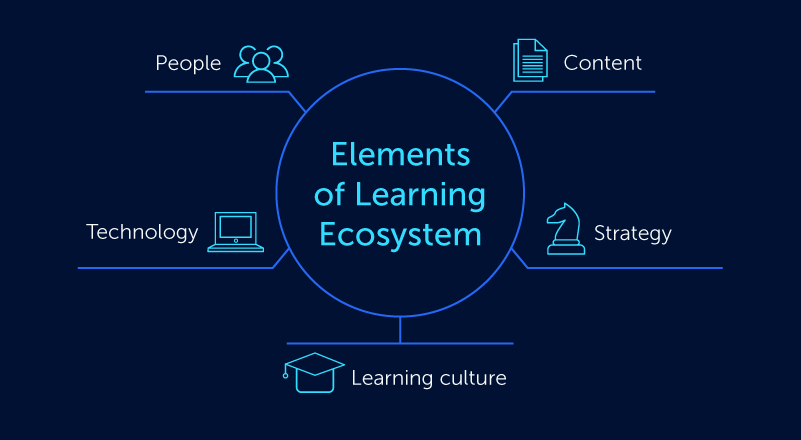
Generally speaking, the employee learning experience can be defined by five key components of the broader ecosystem:
1. People
Ultimately, the people learning are the most crucial element of your ecosystem. They are the primary beneficiaries and who the whole system should be built around.
Utilizing a thriving learning ecosystem helps organizations generate more value from their employees. This could materialize via more efficient workflows, improved products, better customer experiences, or other business benefits.
Beyond learners, there are also the people imparting knowledge within the ecosystem. These could be formal training instructors, managers or team leaders, experienced staff members, or people external to the organization, such as friends and family.
It is important to remember employees acquire knowledge from many people, some of which the organization has no control or say over.
People within the business’s leadership also have a critical role in overseeing the whole learning ecosystem, for example, making decisions regarding strategy, goals, content, delivery, and technology. They also define and set the tone for company culture and whether it is conducive to employee development.
Related articles: 11 Employee Development Methods and Employee Engagement
2. Content
L&D teams spend much of their time creating, evaluating, and adjusting the content for formal training courses. This could include:
- Course structures
- Slide presentations
- Training manuals
- Guides
- Video courses
- Learning based games
- FAQs
- Interactive content
- Assessment strategies
With HR staff dedicated to curating the best training content for the organization, tailored to specific teams or individuals, businesses can get the most out of their workforce and achieve L&D goals.
However, the learning ecosystem covers less formal content resources as well. Staff may pick up new knowledge and skills away from planned training, such as conversations with colleagues. For example, long-serving staff may pass on institutional knowledge gained through years of service at the company.
Educational content can also come from external resources. These are typically specific to the employee and depend on the people they surround themselves with, the media they consume, and any personal development they strive for outside the workplace. This could include mentors, friends working in similar fields, books, articles, podcasts, YouTube videos, documentaries, and any extracurricular education such as night school or weekend classes.
Related articles on how to create more engaging content based on different instructional design models: ADDIE and SAM models
3. Technology
In recent years, technology has seen tremendous growth across many sectors. This includes L&D, with new technologies now playing a massive role within the learning ecosystem, helping people develop new training content, deliver it in more innovative methods, and collect feedback and data that can improve big-picture L&D strategy.
In general terms, technology means more educational content is available more of the time to more people.
Employees can now access learning resources on their own terms and use social media or other forms of online communication to interact, collaborate, and help each other along the way. Technology also enables creative blended learning programs where traditional instructor-led sessions combine with digital tools to enhance learning outcomes.
The two primary technology options available to support learning ecosystems are:
- Learning Management Systems (LMS) – software designed to create, distribute, manage, and store educational content. While there are various types of LMS, they generally allow HR staff to upload resources, deliver them to employees, send notifications, and grant access to authorized individuals.
- Learning Experience Platforms (LXP) – software designed to create personalized learning experiences. LXPs combine resources from various sources, making specific recommendations for each employee and often utilizing artificial intelligence to guide decision-making.
LXPs are typically seen as an evolution of the LMS, creating a more integrated platform able to tailor and aggregate relevant content for specific employee pathways. In contrast, an LMS often acts as simply a data store, cataloging online courses and their material for future use.
Technology for accessing learning resources can be enhanced using authoring tools. These are software packages helping L&D professionals create the content for their training programs without the need for technical programming knowledge. In addition, they can include a range of media options and delivery methods.
E-learning content produced using authoring tools can be tracked using various specifications. The most popular are SCORM (Shareable Content Object Reference Model) and xAPI (eXperience API).
While learning technologies may have taken a narrow approach in the past, learning technology equals accessing an LMS online. A successful approach now integrates technology across the ecosystem to increase interaction and cooperation between components.
A helpful way to visualize technology fitting into the modern learning ecosystem is to consider the four layers of L&D (training operations, training resources, learning delivery, and learner experience) and how they impact the different ways people learn (i.e., formal to informal learning).
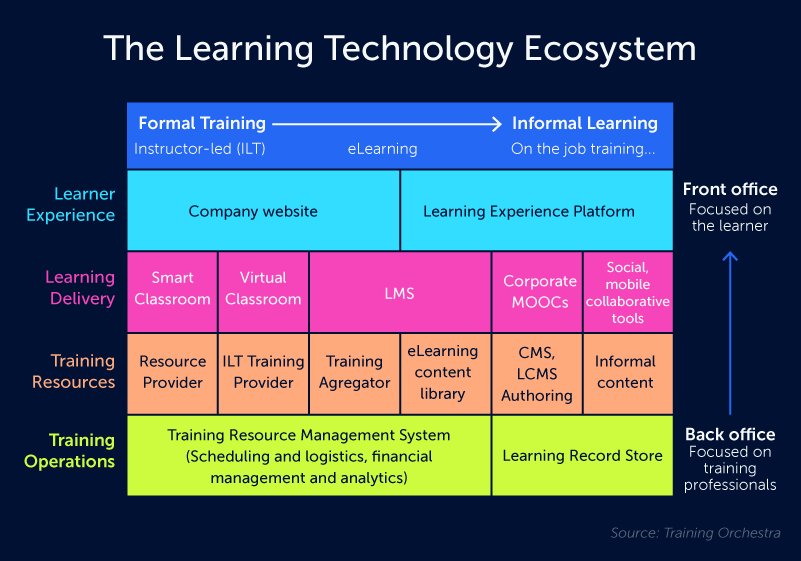
The diagram above moves from the most formal learning on the left to the least on the right (horizontal axis) for each of the four layers (vertical axis). These layers are arranged to represent a move from the back office (focused on training professionals) to front office processes (focused on learners).
As you can see, a range of different technologies can help at each stage for both formal and informal learning.
4. Learning culture
While perhaps harder to define than other components, learning culture sets the tone for the rest of the ecosystem. It shows people how to act and lets them know what to expect when it comes to L&D at a particular organization.
The best learning cultures drive engagement, promote continuous learning, and help employees interact with learning ecosystem components regardless of how they want to develop themselves.
Read the Helmes’s story of how they creates the holistic learning ecosystem to support individual growth
5. Strategy
While leadership significantly affects the four previous components, they are also the result of factors out of their control. However, an organization can entirely define its’ strategy and where they choose to focus employee development.
L&D requires an overall objective and strategy that informs all future decisions. Organizations can try orienting their learning ecosystem to work towards their strategic end goals. However, without a guiding plan in place, learning ecosystems fail to improve the L&D experience of employees, leading to wasted spending and little value produced.
It is also crucial to remain flexible and respond to the specifics of your workforce. You should not stubbornly force strategies found to be ineffective on your workforce, instead casting them aside in favor of those that may achieve more significant results.
Read: Learning and Development (L&D) strategy: How to create an effective one

L&D strategy framework
You will receive a list of questions along with a spreadsheet template to help you analyse your L&D strategy.
DOWNLOAD FRAMEWORKWhy you need a learning ecosystem
Learning ecosystems help L&D staff consider an organization’s entire learning infrastructure, including the abovementioned components. This provides a holistic view of your L&D efforts and every component impacting them. When taken as a whole, organizations can design their learning ecosystem as one, incorporating complementary processes and ideas to enhance the overall learning experience.
Benefits of having organized learning ecosystem:
- Producing personalized development programs
- Offering convenient access such that employees can learn when it best suits them
- A decentralized approach to learning, driven by multiple components and not solely dictated by management
- Ensuring knowledge is better retained and applied to relevant workplace situations
- Greater agility with an ecosystem that can respond and evolve to change effectively
- Generating a more engaging learning experience such that employees are more engaged in their day-to-day work
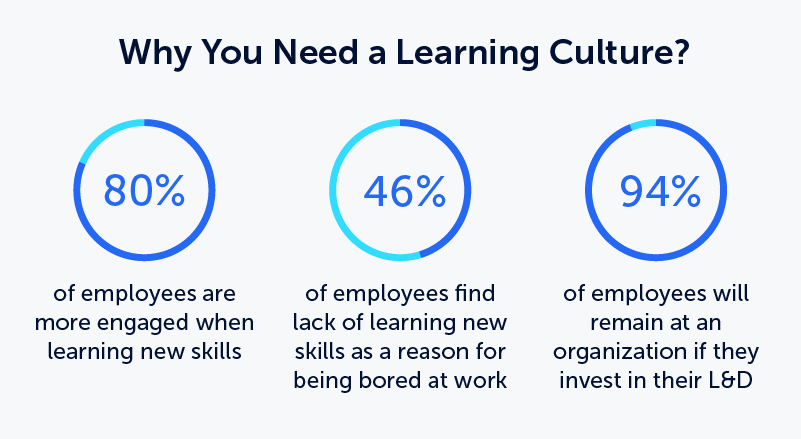
Thriving learning ecosystems create the perfect environment to acquire new skills. Studies show that 80% of workers are more engaged when learning new skills and 46% say the lack of opportunity to learn new skills is a reason for them being bored at work. Disengaged or bored workers are more than twice as likely to leave a company. Conversely, LinkedIn surveys show that 94% of employees would remain at an organization if they invest in their L&D, dramatically reducing costs related to employee turnover.
Improving employee engagement has multiple benefits for an organization. For example, highly engaged teams increase productivity by 21%, and employees who feel heard become 4.6x more likely to perform their best work.
The best learning ecosystems incorporate high-impact learning cultures. These allow employees to become active participants in their education, and learning goes beyond formal settings to become an integral part of their work lives.
Research by Oracle shows organizations that take the time to ingrain a high-impact learning culture within their workforce reap significant benefits, becoming:
- 37% more productive (even higher than highly engaged employees)
- 34% better at responding to customer needs
- 32% more likely to deliver a product to market first
- 26% better at delivering quality product
- 17% more likely to be the market-share leader for their respective sector
- 58% more likely to have the skills necessary to meet future demand
Digital transformation and the changing nature of work means employers are asking for very different skill sets from their staff. Therefore, future-proofing your workforce and developing a learning ecosystem to enhance the acquisition of new, more relevant skills is more critical than ever.
The World Economic Forum predicts the new technology-driven era of business will require reskilling more than 1 billion people by 2030.
How to build a corporate learning ecosystem
While they are complicated and depend on many interconnected factors, there are active steps organizations can take to help build a flourishing corporate learning ecosystem.
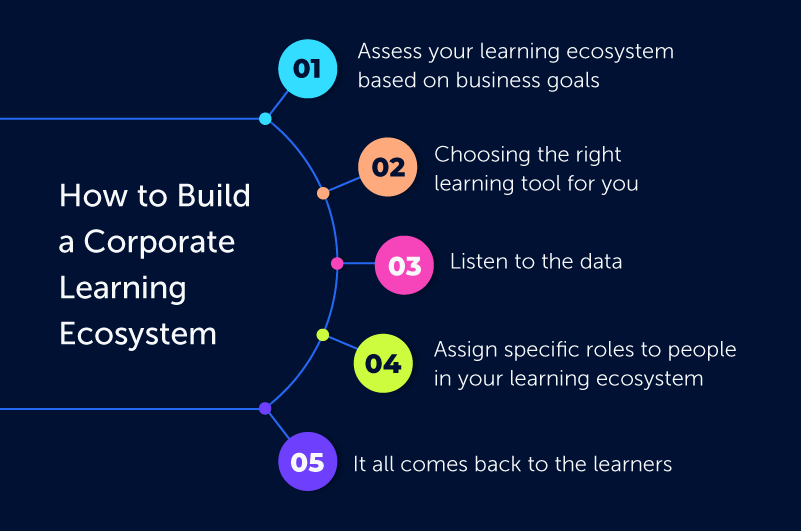
1. Assess your learning ecosystem based on business goals
Your learning ecosystem should reflect the objectives of your business. It is not worth making significant investments in a learning ecosystem without first understanding what you want to achieve with your workforce’s new competencies.
Examples could be related to:
- Reskilling for new digital workflows
- Building up expertise to expand the business in a new direction
- Improving operational efficiency and productivity
Whatever improvements you are looking for, they need to remain the focus of your decision-making moving forward.
Given their complex nature, assessing the impact of investments in a learning ecosystem can be challenging. However, with clear business goals in mind, you can develop the metrics required to understand the value your ecosystem adds. For example, this could be employee feedback on their learning experience or KPIs related to employee performance pre and post ecosystem investment.
2. Choosing the right learning tool for you
To get the most out of educating your employees, you will need to integrate technology fully into the process. The right learning tools can provide the access and functionality required for continuous learning that also fits each employee’s preferences. This includes both how they like to learn and when they want to learn.
Technology provides instant connectivity between the other learning ecosystem components. Without this, it is difficult for a learning ecosystem to achieve its potential.
Whether you want to provide easy access to resources using an LMS, expand functionality to be able to tailor competency-based training for each employee using an LXP, or you’re looking for a complete end-to-end solution to manage your entire ecosystem, there are now tools available to match your needs.
The learning tool you settle on should be a self-serve platform, offering employees autonomy and promoting collaborative learning. You want a learning ecosystem to thrive without constant reinforcement from the management of HR staff. Giving staff the tools to learn on their own time and interact with others while learning helps deliver an organic ecosystem aided by but not solely reliant on formal training.
Read: LXP vs. LMS: which platform to choose?
3. Listen to the data
Beyond providing tools that enhance the learning ecosystem, technology also provides the data needed to help the learning ecosystem improve with time. By tracking employee learning habits and integrating feedback systems, technology can show you the practices having the most impact on the learning experience.
This could be something as simple as understanding the most popular LMS or something more advanced and analytics-based. By going deep into the numbers, you can optimize employee learning practices within your ecosystem and deliver the right content at the right time to the right people.
4. Assign specific roles to people in your learning ecosystem
While many components are involved, you should never forget learning ecosystems are built by and for people. Rather than leaving things to chance, it helps to proactively assign responsibilities to specific individuals within the learning ecosystem.
Examples of these roles include:
- L&D staff – facilitating the whole ecosystem by creating and delivering content, implementing learning tools, understanding the overall strategy, and helping to define the interaction between the various components.
- Management and supervisors – communicating the importance of learning and employee development, motivating team members, and setting the tone for an organization’s learning culture
- Leadership – define the overall strategy and goals of the learning ecosystem and support its development.
- Employees – consume the learning content and provide accurate, actionable feedback based on their experience.
5. It all comes back to the learners
The L&D staff, technology, content, strategy, and culture all combine to build the overall learning ecosystem. While these components are the ecosystem’s input, remember the whole system is there to help the learners. Employees, the new capabilities they acquire, and how they benefit the business are the output of all this work.
So when building your learning ecosystem, ensure that your employees are the focus
A final word
Organization-centric ecosystems come in many shapes and sizes and depend on various factors, including the existing workforce, L&D strategy, training delivery, and more.
But, generally speaking, you get out what you put in – the success of an organization’s ecosystem depends on the impetus provided by leadership and HR staff. Through investment, empowering the right people, and the effective use of technology, organizations can generate valuable learning ecosystems that:
- Improve employee engagement
- Reduce the costs associated with upskilling and reskilling
- Foster new, innovative ideas
- Promote open and collaborative learning experiences
- And more
The digital learning ecosystem workbook
You’ll get a list of useful questions and tasks to help you know your learning space better and ways to improve it.
DOWNLOAD WORKBOOK
